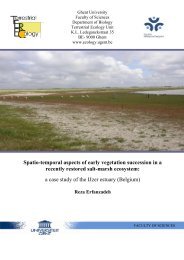PhD Arthur Decae 2010 - Ghent Ecology - Universiteit Gent
PhD Arthur Decae 2010 - Ghent Ecology - Universiteit Gent
PhD Arthur Decae 2010 - Ghent Ecology - Universiteit Gent
You also want an ePaper? Increase the reach of your titles
YUMPU automatically turns print PDFs into web optimized ePapers that Google loves.
Material and Methods<br />
In order to evaluate the origin and affinities of the Mediterranean mygalomorph fauna, two<br />
basic questions have to be answered: 1) which species do exist in the Mediterranean and 2)<br />
where are they to be found To answer these questions at, the species level, extensive and<br />
detailed taxonomical revision is necessary for all Mediterranean genera although the<br />
information presented in the forgoing chapters on Nemesia, Iberesia, Ummidia and<br />
Cyrtocarenum may be regarded as promising first steps. Much work remains to be done even<br />
at a basic level of species discovery and description. At the family and genus levels some<br />
insight is given here in the form of a quick identification key to Mediterranean genera and a<br />
set of distribution maps (see below). The necessary data on the distribution and diversity were<br />
collected in a survey of the extant literature, museum collections and large private and<br />
institutional collections from regions all over the area of interest. A total of 1430 locations<br />
were thus far recorded (Table 2) to produce the distribution maps (Figs.1-13). Over 600<br />
specimens of this sample, including representatives of all Mediterranean genera, were<br />
morphologically studied with the aid of a Ceti-Medo 2 binocular microscope in order to<br />
assess diagnostic taxonomical characters necessary for taxonomic revision. The result of this<br />
survey is summarized in the key given below. The collected information on the geographic<br />
origin of all specimens studied was amassed in a Microsoft Access Data Base and analyzed<br />
for distribution and diversity with the aid of DIVA-GIS geographical computer program<br />
(Hijmans et. al. 2005). The resulting distribution maps are shown in Figs.1-13. In order to<br />
study the affinities of the Mediterranean mygalomorph fauna with that of distributions of<br />
related Mygalomorphae the mapped results were compared with biogeographical information<br />
as it is reported in the Word Spider Catalog (Platnick <strong>2010</strong>). Inset maps indicate distributions<br />
of related taxa outside the Mediterranean. The hatched regions only indicate the countries for<br />
which the relevant taxa are recorded in the WSC (Platnick <strong>2010</strong>).<br />
Results<br />
Key to Mediterranean Mygalomorph Genera<br />
1) Spinneret number six………………………………………………. Atypus<br />
two……………………………………………… Iberesia<br />
four…………………………………………… 2)<br />
2) Claw tufts present, 3 rd claw absent (paired claws present) ……... 3)<br />
Claw tufts absent, 3 rd claw present ……………………..……………... 4)<br />
3) Occular process present, male tibia I unmodified …….………………. Ischnocolus<br />
Occular proces absent, male tibia I male with spur …..………………. Chaetopelma<br />
4) Dense scopula on anterior tarsi and metatarsi …………………….. 5)<br />
Scopulae anterior tarsi and metatarsi absent (or very thin in males only) 6)<br />
5) Occular process absent ............................................................ Cyrtauchenius<br />
Occular process present ……………………………………… 7)<br />
6) Dense spinefields on anterior tarsi and metatarsi, spinnerets short 9)<br />
Dense spinefields absent, PLS very long PMS wide apart<br />
Macrothele<br />
7) PLS short, distal segment domed, PMS close together Nemesia<br />
PLS long, distal segment digitiform, PMS wide apart 8)<br />
8) Males tibia I with distal spur carrying twin hooks Brachythele<br />
Male tibia without spur (only distal spines)<br />
Raveniola<br />
9) Eye-group split, ALE placed separately and far forward Idiops<br />
Eye-group not split, much wider than long, occular process absent, Cyrtocarenum<br />
Eye-group compact roughly rectangular, slight occular proces present 10)<br />
10) Tibia III with saddle depression ……………………………………… Ummidia<br />
Tibia III without saddle ………………………………………. Cteniza










